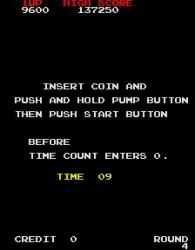This post concentrates on "Persuasive Games: The Expressive Power of Videogames" by Ian Bogost. Bogost specialises in games about social & political issues.
Procedure & Rhetoric
Bogost starts by defining two terms:
- Procedure -- "a way of creating, explaining or understanding processes" (where 'processes' refer to the operation of systems ranging from mechanical to religious concept structures).
- Rhetoric -- "effective and persuasive expression"
Persuasion
 Games make use of persuasion for different purposes. One major goal of arcade games is to get 'coin drop' -- in other words, to make money. One tactic used is the option "Insert coin to continue" which uses the incentive of further exciting gameplay without having to regress to the start. To pressure the player into an emotional decision (which gives increased likelihood of a positive reaction), this is often a limited-time offer accompanied by a countdown clock.
Games make use of persuasion for different purposes. One major goal of arcade games is to get 'coin drop' -- in other words, to make money. One tactic used is the option "Insert coin to continue" which uses the incentive of further exciting gameplay without having to regress to the start. To pressure the player into an emotional decision (which gives increased likelihood of a positive reaction), this is often a limited-time offer accompanied by a countdown clock.Bogost also focuses on the use of persuasion to emphsise political & social messages. However, as this is not relevant to my main study I have skipped this.
Licensing & product placement are certainly big areas. Bogost illustrates the power of licensing through the example of Harry Potter video games. Many of these games re-create scenes, allowing the player to re-experience favourite sequences with a little interaction (something of note for my nostalgia research). Some offer teamwork exercises, others have sub-goals focusing on the minor aspects of the Potter universe (such as collecting Bertie Botts' Every Flavour Beans or mixing potions). What is interesting is that most of these games add very little that is new to the Harry Potter experience.
It's my observation that product placement has significant overlap with licenced/franchised intellectual property (IP), but specifically offers an opportunity to drop messages into a game which might not otherwise be included. For example, if a car street-racing game includes an advertising hoarding for Red Bull energy drinks, the player is likely to subliminally accept a connection between the brand and the excitment, hipness & coolness of motor racing.Aesthetically & narratively abstract games (such as Pong) can be easily adapted into tools for persuasion by the simple addition of images or extrinisic backstory which link the game to a particular product or message (so long as this is reasonably compatible).
Practical application
 This book has provided some valuable insight, and had also prompted an idea (see previous post) of using the abstract Escape! block-dodging game to investigate the psychological effect of adding visual product placement.
This book has provided some valuable insight, and had also prompted an idea (see previous post) of using the abstract Escape! block-dodging game to investigate the psychological effect of adding visual product placement.I intend to investigate three variations:
- Plain, abstract graphics
- Gratuitous product placement (e.g. company logos)
- Game-mechanic-related product placement (e.g. Vince Vaughn character avoiding bouncing balls, mimicking the sports gameplay within the movie Dodgeball.)
